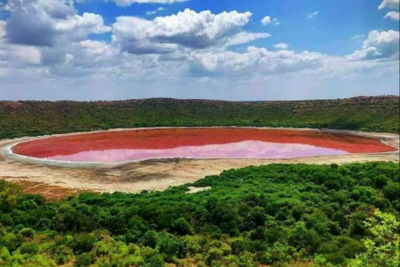ARTICLE AD BOX

Photo: Maharashtra Tourism
Sometimes, nature presents some instances that are so unbelievable, that they seem to be pulled from a dream. One such marvel happened amid a crater lake born from a meteor’s fiery impact some 56,000 years ago.
The water of a crater lake changed from green to pink, and it sent chills down people’s spines!
What is the mystery behind the 56,000‑year‑old Indian crater lake
Lonar Lake, located in Maharashtra’s Deccan Plateau, was formed when a meteor slammed into basalt rock roughly 56,000 years ago, making it one of the few impact craters in basalt worldwide and a protected national geo‑heritage monument. The lake is saline and alkaline, with pH levels soaring to around 10.5, which are among the uncommon values in most natural lakes.
What and why exactly happened
In early June 2020, the lake shifted from its usual green-green tint to a blush pink overnight. Scientists from the Agharkar Research Institute (ARI) in Pune, along with the National Environmental Engineering Research Institute (NEERI), investigated the cause and traced it to salt-loving microbes known as Haloarchaea, which are tiny organisms that live in hyper-saline, alkaline conditions and produce bright pink pigments, as per a report from the Hindustan Times.
When samples were allowed to settle, the biomass sank, and the water turned clear again, confirming it was a microbial bloom, not chemical pollution.TOI reported that the environmental conditions played a key role: unusually low rainfall, high temperatures, and water evaporation raised salinity and pH levels. This created ideal growth conditions for the halophiles. Once monsoon rains began, salinity dropped, and green algae resurgence restored the lake's typical emerald hue.
Interestingly, researchers also said that flamingos frequent the lake during this time. The pigmented microbes provide carotenoid-rich food, which is a reason why these birds have a pink plumage, and surprisingly, perhaps flamingos are instinctively drawn to this unusual feast.
More about Lonar Lake
According to the NASA earth observatory, Lonar Lake, also known as Lonar Crater, is found in the west-central part of India, in the state of Maharashtra.
Because it sits in the middle of the volcanic basalt landscape of the Deccan Plateau, many people once believed it was formed by a volcano.But in the 1970s, scientists discovered a special type of natural glass called maskelynite at the site. This glass only forms during extremely high-speed impacts, like when a meteor hits the ground. That’s when they confirmed that Lonar Lake was created by a meteor strike, not a volcano.



.png)
.png)
.png)
















 3 hours ago
3
3 hours ago
3









 English (US) ·
English (US) ·